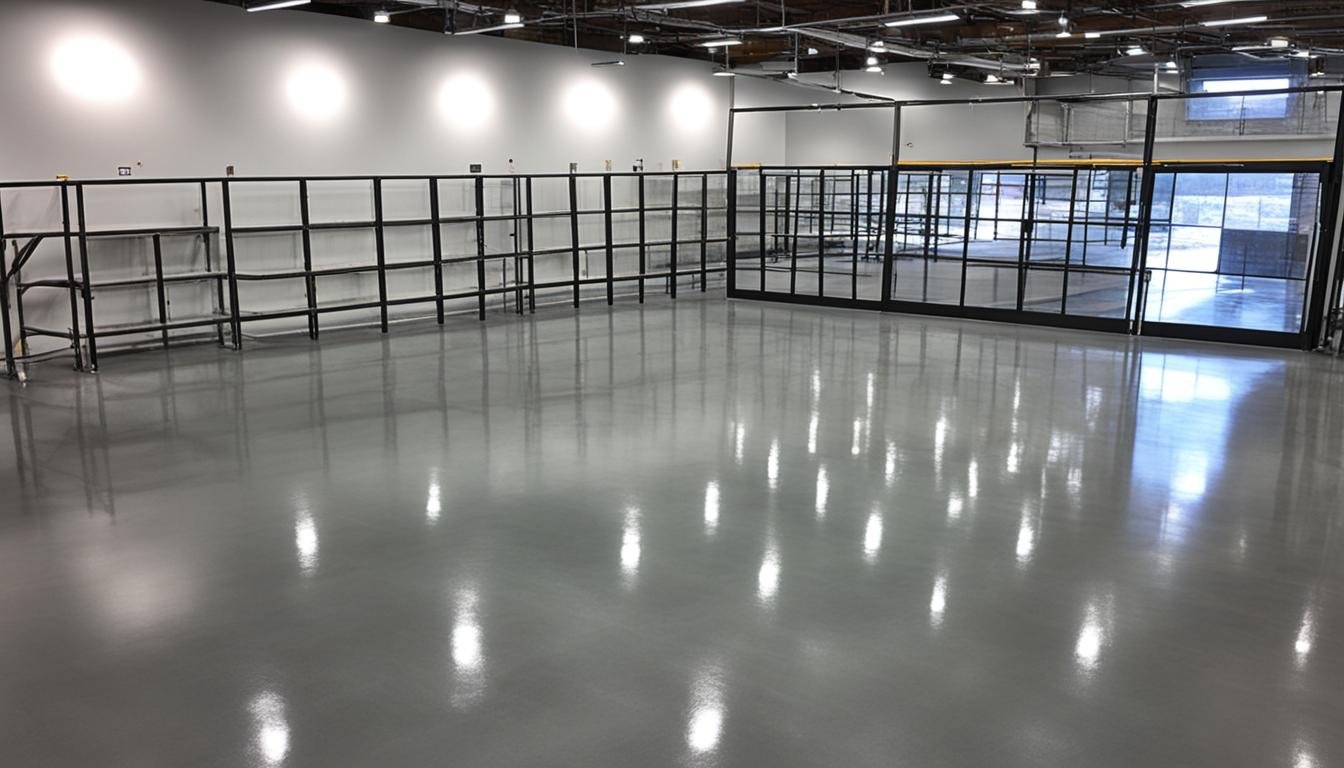How Do Concrete Slabs Compare to Other Flooring Options?

Welcome to our guide on concrete slabs in Bakersfield! If you’re considering different flooring options for your space, it’s important to weigh the pros and cons of each. In this section, we’ll explore how concrete slabs measure up against other popular choices.
Concrete is a versatile and durable flooring material that has gained popularity in both residential and commercial settings. Understanding its benefits and drawbacks can help you make an informed decision for your specific needs in Bakersfield.
Whether you’re looking for a cost-effective solution, a low-maintenance option, or a flooring material that offers a unique aesthetic appeal, we’ll delve into how concrete slabs compare to other popular flooring choices such as hardwood, tile, carpet, and laminate.
By the end of this guide, you’ll have a clear understanding of the advantages and disadvantages of using concrete slabs as flooring and how they stack up against other materials in Bakersfield.
The Benefits and Drawbacks of Concrete Slabs
When considering flooring options for your space in Bakersfield, concrete slabs offer a range of benefits and drawbacks. Understanding these factors is crucial in making an informed decision. Let’s explore the advantages and disadvantages of using concrete slabs as flooring, comparing them to other popular options.
Advantages of Concrete Slabs
- Durability: Concrete slabs are known for their exceptional durability, making them suitable for high-traffic areas.
- Cost-effectiveness: Compared to many other flooring materials, concrete slabs can be a cost-effective choice, especially for larger spaces.
- Low maintenance: Once properly sealed, concrete slabs are relatively easy to clean and maintain, requiring minimal effort.
- Design versatility: With endless possibilities for customization, concrete slabs can be stained, stamped, or polished to achieve various aesthetic effects.
Drawbacks of Concrete Slabs
- Hardness: Concrete slabs can be hard underfoot, which may not be as comfortable as some softer flooring materials.
- Coldness: Without proper insulation or radiant heating, concrete slabs can feel cold, especially in colder climates.
- Installation complexity: Installing concrete slabs requires careful planning and professional expertise to ensure proper leveling and curing.
- Longevity: While generally long-lasting, concrete slabs may develop cracks over time, requiring occasional repairs.
Now that we’ve explored the benefits and drawbacks of concrete slabs, it’s important to compare them to other flooring options in Bakersfield. In the next section, we’ll dive into detailed comparisons between concrete slabs and popular materials like hardwood, tile, carpet, and laminate.
Comparing Concrete Slabs to Different Flooring Materials
When it comes to choosing the perfect flooring for your space in Bakersfield, there are several options to consider. In this section, we will compare concrete slabs to popular flooring materials such as hardwood, tile, carpet, and laminate, allowing you to make a well-informed decision based on your specific needs and preferences.
Hardwood Flooring
Hardwood flooring is known for its timeless beauty and durability. It adds warmth and elegance to any room. However, hardwood floors require regular maintenance and are prone to scratches and damage over time. Additionally, hardwood flooring can be quite expensive to install and may not be suitable for areas with high moisture levels.
Tile Flooring
Tile flooring is a popular choice for kitchens, bathrooms, and other high-traffic areas. It is highly resistant to water and stains, making it easy to clean and maintain. Tile flooring offers a wide range of design options, allowing you to create unique patterns and styles. However, tile floors can be cold underfoot and may require professional installation to ensure proper sealing and grouting.
Carpet Flooring
Carpet flooring is loved for its softness and comfort. It provides insulation, reduces noise, and adds a cozy feel to any room. However, carpet can be prone to stains and may require regular cleaning and maintenance. It is also not suitable for areas with high moisture levels, as it can promote mold and mildew growth.
Laminate Flooring
Laminate flooring is a cost-effective alternative to hardwood and tile. It mimics the look of natural materials, offering a wide variety of styles and designs. Laminate floors are durable, easy to clean, and resistant to scratches and dents. However, they may not withstand heavy moisture exposure and are not as long-lasting as other flooring options.
Now, let’s compare these flooring options to concrete slabs in terms of lifespan, installation process, versatility, and eco-friendliness:
| Flooring Material | Lifespan | Installation Process | Versatility | Eco-friendliness |
|---|---|---|---|---|
| Concrete Slab | 50+ years | Requires professional installation | Versatile, can be polished, stained, or textured | Eco-friendly, as it can be made from recycled materials and is energy-efficient |
| Hardwood | 100+ years with proper care | Requires professional installation | Limited options for customization | Natural material, but can contribute to deforestation |
| Tile | 50+ years with proper care | Requires professional installation | Wide range of styles and patterns | Can be made from natural materials like clay, but energy-intensive production process |
| Carpet | 10-15 years with regular cleaning and maintenance | Can be installed by professionals or DIY | Wide range of colors and textures | Not eco-friendly, as it can emit volatile organic compounds (VOCs) |
| Laminate | 15-25 years with regular care | Easy DIY installation with click-lock system | Various designs and styles available | Not eco-friendly, as it is made from synthetic materials |
As you can see, concrete slabs offer a long lifespan, requiring professional installation. They are highly versatile and can be customized to suit your aesthetic preferences. Concrete slabs are also eco-friendly, making use of recycled materials and being energy-efficient.
Image:
Conclusion
After carefully considering the pros and cons of using concrete slabs as flooring and comparing them to other popular options, you are now equipped with the knowledge to make an informed decision for your space in Bakersfield. Concrete slabs offer several advantages that make them a compelling choice.
Firstly, concrete slabs are highly durable, capable of withstanding heavy foot traffic and lasting for many years with minimal maintenance. They are also an affordable flooring option, especially when compared to materials like hardwood or tile. This cost-effectiveness makes concrete slabs an attractive solution for both residential and commercial spaces.
Moreover, concrete slabs can be versatile in terms of design. They can be polished, stained, or stamped to create unique patterns and finishes, adding an aesthetic appeal to any interior. Additionally, compared to other flooring materials, concrete slabs are known for their eco-friendliness, as they are often made with locally sourced materials and can contribute to improved energy efficiency.
While concrete slabs offer numerous benefits, it’s essential to consider the specific requirements of your space and personal preferences. Take into account factors such as the desired aesthetic, maintenance needs, and the comfort levels you expect from your flooring. By carefully weighing these considerations, you can confidently decide whether a concrete slab is the ideal flooring solution for your needs in Bakersfield.
FAQ
How do concrete slabs compare to other flooring options?
Concrete slabs offer several advantages over other flooring options. They are highly durable, long-lasting, and require minimal maintenance. Additionally, concrete slabs are cost-effective and can be customized with various finishes and designs.
What are the benefits of using concrete slabs as flooring?
Concrete slabs have numerous benefits. They are known for their durability and can withstand heavy foot traffic and wear and tear. Concrete slabs are also resistant to moisture and stains, making them an excellent choice for areas prone to spills. Additionally, they provide excellent thermal conductivity, helping to regulate indoor temperatures, and are compatible with radiant heating systems. Lastly, concrete slabs are eco-friendly as they do not require the use of additional materials like carpets or tiles.
Are there any drawbacks to using concrete slabs?
While concrete slabs offer many advantages, they do have a few drawbacks. Concrete can be hard on the feet and less forgiving than softer flooring materials. Without proper sealing or finishes, concrete slabs can also be susceptible to cracking and can feel cold underfoot. However, these issues can be mitigated by using area rugs or applying a suitable sealant.
How do concrete slabs compare to hardwood flooring?
Concrete slabs and hardwood flooring have different characteristics. Concrete slabs are highly durable, moisture-resistant, and low maintenance, while hardwood flooring offers a warm and natural aesthetic. Hardwood is prone to scratches and can be damaged by moisture, making it less suitable for high humidity environments or areas prone to spills. Concrete slabs are typically more cost-effective and require less maintenance in the long run.
Do concrete slabs offer the same design options as tile?
Concrete slabs offer a wide range of design options similar to tile. They can be stained, stamped, or polished to achieve various colors, patterns, and textures. Concrete slabs can mimic the look of tile or even replicate the appearance of other materials like wood or stone.
Are concrete slabs compatible with radiant heating systems?
Yes, concrete slabs are an ideal choice for radiant heating systems. Their excellent thermal conductivity allows for efficient heat distribution, resulting in a comfortable and energy-efficient heating solution for your space.
Can I install carpet over a concrete slab?
Yes, carpet can be installed over a concrete slab. However, it is important to ensure proper moisture prevention measures are in place to avoid mold or mildew growth. Installing a moisture barrier and using padding specifically designed for concrete floors can help mitigate these risks.
